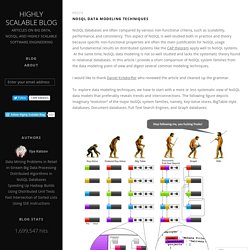

So Many Ways to Start Your Mongo. Starting up a vanilla MongoDB instance is super easy, it just needs a port it can listen on and a directory where it can save your info.

By default, Mongo listens on port 27017, which should work fine (it’s not a very commonly used port). We’ll create a new directory for database files: And then start up our database: 1.$ cd 2.$ bin/mongod --dbpath ~/dbs/mydb …and you’ll see a bunch of output: 01.$ bin/mongod --dbpath ~/dbs/mydb 02.Fri Apr 23 11:59:07 Mongo DB : starting : pid = 9831 port = 27017 dbpath = /data/db/ master = 0 slave = 0 32-bit 04.** NOTE: when using MongoDB 32 bit, you are limited to about 2 gigabytes of data 07.Fri Apr 23 11:59:07 db version v1.5.1-pre-, pdfile version 4.5.
Introducing SpaceBase: a New Realtime Spatial Data Store. March 21, 2012 By Ron Today, we are proud to launch Parallel Universe and introduce our first product: SpaceBase.

SpaceBase is a server-side, in-memory, low-latency, dynamic, concurrent and distributed spatial data-store for 2D and 3D spatial objects. It is meant to be used by MMO (massively-multiplayer online) games, defense applications and location based services. Goodbye, CouchDB. Here at Sauce Labs, we recently celebrated the completion of a significant project to improve our service uptime and reliability, as we transitioned the last of our CouchDB databases to MySQL.

We’d outgrown CouchDB, to the point that a majority of our unplanned downtime was due to CouchDB issues, so wrapping up this migration was an important milestone for us. CouchDB was a very positive experience at first, and its reliability isn’t out of bounds for a database that is, after all, only on version 1.2. But our service is very sensitive to reliability issues, and ultimately we decided that this transition was the most efficient path forward for us. Once we decided on MySQL (specifically, we’re now using Percona, with its InnoDB-based XtraDB storage engine), we rearchitected our DB abstraction layer and one by one migrated all our databases, large and small. This post describes our experience using CouchDB, and where we ran into trouble. First, how did we get into trouble? Riak Compared to MongoDB. This is intended to be a brief, objective and technical comparison of Riak and MongoDB.

The MongoDB version described is 2.2.x. The Riak version described is Riak 1.2.x. If you feel this comparison is unfaithful at all for whatever reason, please fix it or send an email to docs@basho.com. At A Very High Level Riak is Apache 2.0 licensed; MongoDB is distributed under the AGPLRiak is written primarily in Erlang with some bits in C; MongoDB is written in C++
NoSQL Data Modeling Techniques « Highly Scalable Blog. NoSQL databases are often compared by various non-functional criteria, such as scalability, performance, and consistency.

This aspect of NoSQL is well-studied both in practice and theory because specific non-functional properties are often the main justification for NoSQL usage and fundamental results on distributed systems like the CAP theorem apply well to NoSQL systems. At the same time, NoSQL data modeling is not so well studied and lacks the systematic theory found in relational databases. In this article I provide a short comparison of NoSQL system families from the data modeling point of view and digest several common modeling techniques. I would like to thank Daniel Kirkdorffer who reviewed the article and cleaned up the grammar. To explore data modeling techniques, we have to start with a more or less systematic view of NoSQL data models that preferably reveals trends and interconnections. Cripple the Google CDN's caching with a single character.
It’s no secret that I’m a proponent of using a shared CDN to host jQuery.

As more and more sites take advantage of public CDNs for their jQuery reference, the cross-site caching benefit is becoming almost a given. However, there are a couple ways that even I recommend against using these public CDNs. With the impending policy change on hotlinking copies of jQuery hosted on jQuery.com, I expect that at least several sites will be migrating their hotlinked script references to one of the public CDNs soon. So, I think this is a good time to address one CDN-related usage mistake that I’ve seen an uptick in lately. Firesheep and SSL By now, you’ve probably heard about last year’s release of Firesheep, a Firefox addon that sniffs out HTTP session cookies transmitted in cleartext, and the turmoil that it caused. Unfortunately, this recent proliferation of SSL usage has at least one performance drawback that isn’t necessary obvious at first glance.
HTTPS and mixed content An obvious solution.
Arya a MongoDB based Search Engine - Scott Reynolds. Twemproxy. Database/Etc | Software/etc. Lawnchair: Simple JSON Storage.